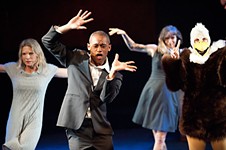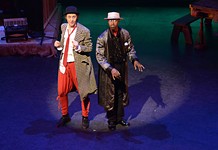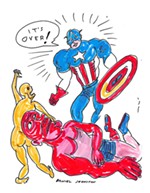Director's Choice/Evolution
In Director's Choice/Evolution, the side-by-side presentation of old and new dances by Ballet Austin's Stephen Mills and Gina Patterson revealed two creators maturing and deepening in their art
Reviewed by Robert Faires, Fri., April 7, 2006

Director's Choice/Evolution
Bass Concert Hall, April 2
Sometimes changes in a person are easy to spot: the paunch where that trim waistline was, the receding hairline, the wrinkles around the eyes. Other times you have to look closely to see them: the gait that's slightly slower, the laugh that's a little less boisterous, a previously unseen wistfulness in the eyes. In this year's Director's Choice program, Ballet Austin artistic director Stephen Mills offered us the chance to spot the changes that the past several years have wrought on him and fellow choreographer Gina Patterson, through dances they have made. Both presented the first works they created alongside their most recent efforts, and while you might have been able to note a few obvious changes between the earlier and later works, this was an instance where the shifts were less pronounced, subtler. But if you made a close study of the work, you could sense, if not see, these two creators maturing, deepening in their art.
Both artists' early works boasted the kind of passion that smacks of youthful energy and an eagerness to stretch one's wings. With Mills' "Red Roses," a grouping of six short dances set to romantic ballads by Edith Piaf, that showed itself in a springtime exuberance, as with Anthony Casati sweeping a swooning Jaime Lynn Witts literally off her feet or Michelle Thompson, vivaciously en pointe, kicking up her heels on her toes, or Beth Terwilleger being comically twisted, turned, and tumbled by a caddish Orlando Julius Canova. This was amour, lively and immediate, as it's been in the dreams and sighs of every would-be Romeo and Juliet since Cupid took up archery. Patterson's "Insideout" also turned on a romantic connection, but with the heat turned up quite a few degrees. The choreographer herself and partner Eric Midgley flashed through a jazzy duet punctuated with enough sharp steps and gestures, not to mention smoldering looks, to almost qualify as flamenco. Its emotions, like those in "Red Roses," were all out there on the surface, on one's sleeve, like a kid's are, which made it all the easier to get swept up in the dance.
The later works were full of feeling, too, but the feelings seemed more complex, ambiguous, marked with the tension of give and take. That couldn't have been more true than in the first section of Mills' "Desire/Three Movements," in which a couple – Patterson and Midgley again – made their way across the stage in a progression of embraces and releases, couplings and separations. Midgley projected such need for Patterson, his hand extended toward hers as if for some life-saving rope or perhaps some part of himself. Her response seemed at times to complement his but at others to conflict with it, as if she was suffocated by his desire. But ah, that's part of the reason desire can be so complicated, yes? The subsequent movements, with their expanded cast moving in competing patterns on different parts of the stage, proved harder to read, as least for this viewer. What did come through clearly was the sense of ambition in the choreographer, of Mills pushing himself further in his art. That was also true in Patterson's "Six of One AND a Half-Dozen of the Other," despite the work's more whimsical tone. Inspired by the life cycle and mating habits of birds, the piece was a kind of "March of the Peacocks," beginning with a dozen dancers hidden behind gigantic white balloons, from which they popped up, hatchlinglike, and proceeded to explore the world. As the dance progressed, these bird figures appeared to mature and pair up for mating. But as those cinematic penguins showed, life as a bird isn't without hardships and pain, and on occasion a dancer stepped apart from the brood for what seemed a melancholy walk beside a sort of peacock queen mother (a visibly pregnant but unassailably regal Margot Brown). These tensions gave the piece, playful as it was, a richer emotional texture, a sense of life with both joys and sorrows, often intertwined. It's the perspective of someone who has lived enough to know that mix of sunshine and rain, and Patterson pushed herself to layer that into her piece. That's the kind of growth in someone that doesn't announce itself like a line around the mouth or graying temple, but you can see it if you look closely. And it's a sign that the evolution of Patterson and Mills is something to applaud. What's the old ad line? "You're not getting older, you're getting better." Indeed.










